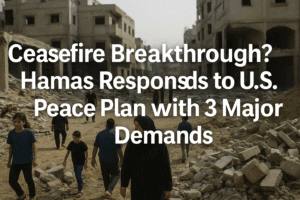Ceasefire Breakthrough? Hamas Responds to U.S. Peace Plan with 3 Major Demands
Hamas has responded “positively” to a U.S.-brokered Gaza ceasefire proposal, signaling potential progress after 20 months of war. The deal includes a 60-day truce, hostage-prisoner exchanges, and increased aid, but key disputes remain. Hamas demands U.S. assurances that Israel won’t resume attacks if talks fail, full troop withdrawals, and an end to the contested GHF aid system. Meanwhile, Netanyahu insists the war continues until Hamas is dismantled and all hostages are freed.
Overnight Israeli strikes killed at least 15 displaced Palestinians in Khan Younis, underscoring the urgency for a deal. In Tel Aviv, hostage families rallied, pleading for an agreement to bring their loved ones home. With famine looming and over 57,000 dead in Gaza, the next few days will determine whether diplomacy can overcome deep distrust. The world watches to see if this fragile opportunity for peace will hold—or collapse like past failed ceasefires.

Ceasefire Breakthrough? Hamas Responds to U.S. Peace Plan with 3 Major Demands
As Gaza’s humanitarian crisis deepens, a potential ceasefire deal hangs in the balance—but will Israel and Hamas bridge their divides?
A Glimmer of Hope Amid Ongoing Bloodshed
Hamas has delivered what it calls a “positive response” to a U.S.-brokered ceasefire proposal, raising cautious optimism after nearly 20 months of devastating war in Gaza. Yet, behind the diplomatic language, critical disagreements persist—leaving civilians trapped between relentless airstrikes and a collapsing aid system.
What’s in the U.S. Proposal?
The plan, backed by President Donald Trump, outlines:
- Hostage-Prisoner Exchange: The phased release of 10 living Israeli hostages and 18 bodies in return for Palestinian prisoners.
- Humanitarian Pause: A 60-day ceasefire to allow negotiations for a permanent end to hostilities.
- Aid Access: Immediate, large-scale humanitarian aid distributed via the UN and Red Cross.
However, Hamas has requested amendments, including:
- A U.S. guarantee that Israel won’t resume attacks if talks fail.
- Full Israeli troop withdrawals to pre-March ceasefire positions.
- An end to the controversial GHF aid distribution system, which critics accuse of inefficiency and bias.
The Sticking Points
- Netanyahu’s Red Lines: Israel’s PM insists the war won’t end until Hamas is militarily crushed and all hostages are freed—a stance at odds with Hamas’ demands.
- The Aid Battle: The UN reports over 500 Palestinians killed near aid points, while the GHF denies responsibility. With famine looming, who controls aid could make or break the deal.
- Civilian Suffering: Overnight strikes in Khan Younis killed at least 15 displaced Palestinians, including children. “The ceasefire will come, and I’ve lost my brother?” asked 13-year-old Mayar al-Farr at his funeral.
Voices from Both Sides
- In Gaza: “Our hearts are broken. Stop this war,” pleaded Adlar Mouamar, mourning his nephew.
- In Tel Aviv: Families of hostages rallied outside the U.S. embassy, demanding action. “Only a comprehensive deal can bring them all home,” said freed hostage Keith Siegel.
Why This Moment Matters
This could be the closest both sides have come to a deal in months—but the window is narrow. With Israel threatening to escalate and Hamas wary of past broken ceasefires, the next few days will test whether diplomacy can outweigh distrust.
While leaders negotiate, civilians pay the price. Whether this proposal succeeds hinges on one question: Can the U.S. and mediators craft guarantees strong enough to satisfy both sides—or will Gaza’s nightmare continue?
You must be logged in to post a comment.